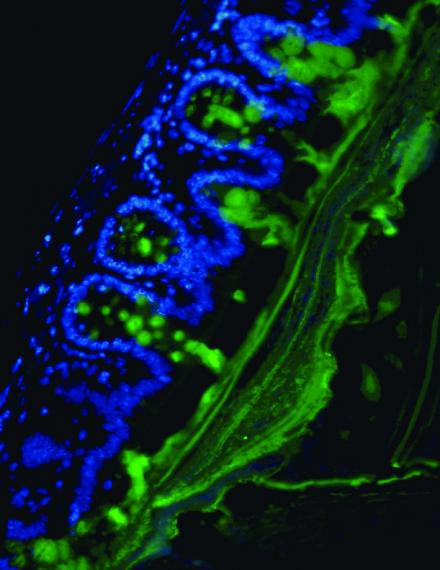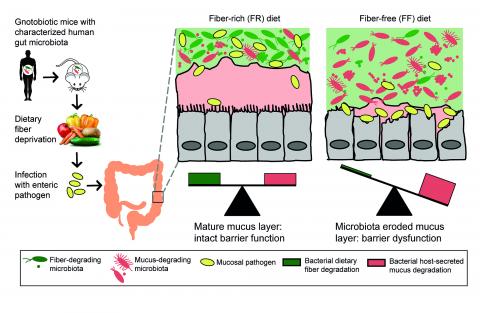It sounds like the plot of a 1950s science fiction movie: normal, helpful bacteria that begin to eat their host from within, because they don’t get what they want.

A thick mucus layer, generated by the cells of the colon's wall, provides protection against invading bacteria and other pathogens. This image of a mouse's colon shows the mucus (green) acting as a barrier for the "goblet" cells (blue) that produce it.
Starved, they begin to munch on the natural layer of mucus that lines the gut, eroding it to the point where dangerous invading bacteria can infect the colon wall.
In a new paper in Cell, (link is external) an international team of researchers show the impact of fiber deprivation on the guts of specially raised mice. The mice were born and raised with no gut microbes of their own, then received a transplant of 14 bacteria that normally grow in the human gut. Scientists know the full genetic signature of each one, making it possible to track their activity over time.
The findings have implications for understanding not only the role of fiber in a normal diet, but also the potential of using fiber to counter the effects of digestive tract disorders.
«The lesson we’re learning from studying the interaction of fiber, gut microbes and the intestinal barrier system is that if you don’t feed them, they can eat you," says Eric Martens, Ph. D., an associate professor of microbiology (link is external) at the University of Michigan Medical School (link is external) who led the research along with his former postdoctoral fellow Mahesh Desai, Ph. D., now a principle investigator at the Luxembourg Institute of Health (link is external).
Using
The result: the mucus layer stayed thick, and the infection didn’t take full hold, in mice that received a diet that was about 15 percent fiber from minimally processed grains and plants. But when the researchers substituted a diet with no fiber in it, even for a few days, some of the microbes in their guts began to munch on the mucus.
They also tried a diet that was rich in prebiotic fiber — purified forms of soluble fiber similar to what some processed foods and supplements currently contain. This diet resulted in a similar erosion of the mucus layer as observed in the lack of fiber.
The researchers also saw that the mix of bacteria changed depending on what the mice were being fed, even day by day. Some species of bacteria in the transplanted microbiome were more common — meaning they had reproduced more — in
And the four bacteria strains that flourished most in

In addition to looking at the of bacteria based on genetic information, the researchers could see which
Just like the mix of bacteria, the mix of enzymes changed depending on what the mice were being fed, with even occasional fiber deprivation leading to more production of
Images of the mucus layer, and the «goblet» cells of the colon wall that produce the mucus constantly, showed the layer was thinner the less fiber the mice received. While mucus is constantly being produced and degraded in a normal gut, the change in bacteria activity under the
When the researchers infected the mice with Citrobacter rodentium — the E.
When the scientists looked at samples of their gut tissue, they saw not only a much thinner or even patchy mucus later — they also saw inflammation across a wide area. Mice that had received a
«To make it simple, the «holes» created by our microbiota while eroding the mucus serve as wide open doors for pathogenic
Martens notes that in addition to the gnotobiotic facility, the research was possible because of the microbe DNA and RNA sequencing capability built up through the Medical School’s Host Microbiome Initiative, as well as the computing capability to plow through all the sequence data.
«Having all the resources here was the key to making this work, and the fact that it was all across the street from our lab allowed us to pin it all together," he says. He also notes the role of
Going forward, Martens and Desai intend to look at the impact of different prebiotic fiber mixes, and of diets with more intermitted natural fiber content over a longer period. They also want to look for biomarkers that could tell them about the status of the mucus layer in human guts — such as the abundance of
«While this work was in mice, the


